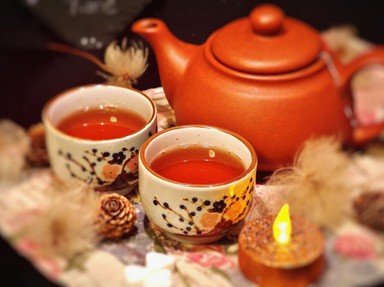Quiz Answer Key and Fun Facts
1. In what country, generally associated with another eye-opening beverage, is tea prepared using two stacked teapots, and drunk from tulip-shaped glasses called "ince belli"?
2. In Myanmar, tea is not just consumed as a beverage, but also as a popular dish named "lahpet". In which pungent, appetizing way are the tea leaves prepared?
3. "Po cha" is the Chinese name of a tea-based drink widely enjoyed in the Himalayan region. What two ingredients are usually added to the tea?
4. Known in the West as "chai latte", masala chai, or spiced tea, is one of India's preferred ways to consume tea. What of these spices would you NOT use to make this beverage?
5. Not surprisingly, tea is an essential feature of Sri Lankan culture. In this island country, tea is often served with a piece of jaggery. What kind of food item is jaggery?
6. In which large country, famous for its elaborate tea urns and tea-drinking traditions, would you use jam as an alternative to sugar to sweeten your tea?
7. North African countries are known for their refreshing mint tea. However, Libya has a tea-drinking tradition all of its own, which involves adding what legumes of South American origin to tea?
8. An icon of the cuisine of the Southern US, and a symbol of Southern hospitality, sweet tea is generally served hot.
9. What name is given to the powdered green tea used for the Japanese tea ceremony, also often added to ice cream, baked goods, and other foods?
10. Mentioning the UK is almost inevitable in a quiz about tea. Which of these 20th-century literary greats, known for writing about pigs and all-seeing eyes, wrote an essay that discusses the art of making the perfect cup of tea?
Source: Author
LadyNym
This quiz was reviewed by FunTrivia editor
Bruyere before going online.
Any errors found in FunTrivia content are routinely corrected through our feedback system.

